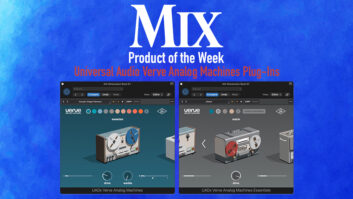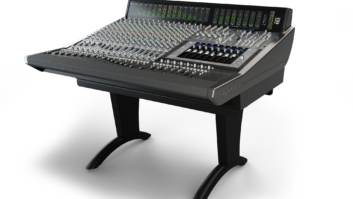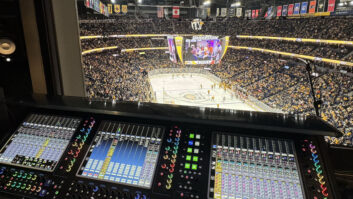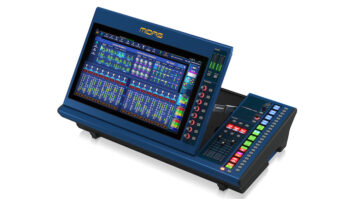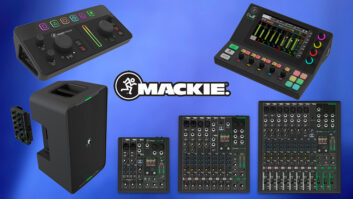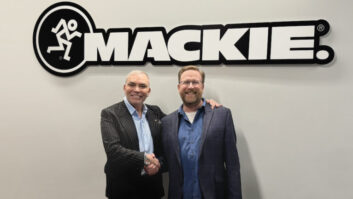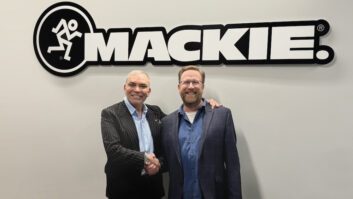In today’s ITB (in-the-box) mixing world, the debut of a new analog mixing console usually gleans comparatively little attention among feature-packed DAW updates and innovative plug-in releases. Unveiled at last year’s AES Convention in New York, the Onyx-i Series of analog consoles — and particularly the flagship model, the 1640i — is an anomaly. It simply can do what no other affordable multipurpose analog mixer has done before, a fact that is true on a multitude of levels of functionality. For these reasons, Onyx-i easily won a 2009 PAR Excellence Award. In conducting this review, I learned exactly why the Onyx-i earned its widespread industry accolades.
Features
Two years ago I bought an original Onyx 1640 analog mixer along with its additional 24-bit/96kHz FireWire I/O card (allowing 16 + mix DAW inputs and stereo mix out). It has been at the center of my personal studio ever since, and I’ve become quite fond of and accustomed to its features. For the money, I haven’t discovered another console out there that serves the same purposes at the same quality level and it has worked flawlessly from day one of ownership. I must also note that the 1640 (just like the 1640i) serves as a great analog mixer for sound reinforcement when 16 input channels is enough.
From an analog perspective, the new 1640i is much the same as its predecessor offering all of the best qualities of the original 1640: four busses; 16 channel strips each with nice Onyx mic preamps; the useful four-band Perkins EQ with sweepable high-mids and low-mids, per channel; available DI on the first two channels; six pre/post channel aux sends; 16 balanced, pre-channel-insert direct outputs (post preamp/pre-EQ) via two DB-25 connectors.
So what’s new? Updated aesthetics — snazzy brushed aluminum edging around a decidedly more rugged-looking chassis — encapsulate three key updates for the 1640i, each based on FireWire-enabled routing features and increased functionality: dual built-in 24-bit/96kHz FireWire ports, allowing 16 channels both in and out; truly comprehensive I/O routing via FireWire, including aux sends, groups, and pre/post EQ for all channels; and — last but not least — a new compatibility with Pro Tools M-Powered 8, via Mackie’s $50 driver downloadable from the Mackie website. This driver effectively turns any Onyx-i mixer into Pro Tools-compatible I/O — one with no need for Avid hardware.
In Use
When I first replaced my 1640 with the 1640i, it behaved and was used just like its predecessor with very few and minor differences — e.g., no main mix trim pot on its now-standard two-port FireWire I/O. Thus, in typical Mackie fashion, well enough was left alone, even in such a significant product update.
Whether recording live tracks to an Alesis HD24-XR via DB-25 analog direct outs or monitoring/mixing pre-recorded tracks with multiple inserted compressors, hardware-based effects via aux sends, and multiple EQs on a console full of line level signal, the 1640i met my high expectations, those originally set by the 1640’s admirable capabilities and good sonic qualities.
Gradually I discovered the essence of the 1640i is how it can serve as a deep comprehensive interface for any Mac or PC-based DAW. As such it becomes an affordable 16×16 FireWire digital I/O with numerous insert points, sends, and built-in EQ, allowing truly creative audio production, in or out of (or somewhere in between) “the box.” For example, in my first two mixing tests using a rock recording project, I utilized my main DAW — Apple Logic — for pre-mix editing, multitrack comping, and submixing, mute and level automation, and digital effects, then sent 12 tracks to the 1640i channels for some EQ, as well as inserted channel compression, outboard EQ, and a few guitar effects from gear I already own, then back in the box as a stereo mix.
That experiment revealed just the tip of the iceberg in signal path possibilities that lie within the 1640i. For studio use, consider subgroup-enabled track bouncing via FireWire following console EQ with patched-in outboard compressors or mixing a studio project (or live event) while using DAW-based effects: routing the 1640i’s aux sends via FireWire to a DAW for multiple mono in/stereo out processors (and back to console via input switches FW1 and FW2). Analog/digital I/O options abound when an Onyx-i is the nexus. I’ve already tried a few of these techniques with much success and am eager to attempt many more.
On Pro Tools M-Powered Compatibility: The Big Picture
Considering the “whoa, dude” aspect of what was actually happening — the loading of a Mackie driver to run Pro Tools! — driver setup was anti-climactic. Just one quick call to Tom, a friendly Mackie Tech Support team member, regarding my driver authorization number and a couple of Audio/MIDI utility setting questions, and I was up and running with PT M-Powered via Mackie’s driver, streaming 16 channels of audio back and forth between the 1640i and my Mac.
Other than the small NRV-10, M-Audio — the division of Avid that offers Pro Tools M-Powered 8 — sells no analog mixer/digital I/O products. For that reason, particularly in the marketplace of serving self-recorders with aspirations of pro-competitive productions, Onyx-i is a potentially game-changing product line based on just this one feature. For example, I’ve been consistently using Apple Logic since I left Pro Tools LE years ago. Based on my time with this particular piece of Mackie hardware — which I mainly intended to use with my non-Avid DAW — I decided to stick my toe back into the PT pool, purchasing Pro Tools M-Powered 8 (affordable at $249 street), and now feel encouraged to use it in fair exchange with Logic. After all, PT is clearly still the industry-standard pro DAW, so having Pro Tools in my arsenal can arguably make it easier to collaborate with others during my own production process (for example, I may choose the PT platform when I ultimately plan to work with an outside mix engineer, most of which are firmly in the PT camp). As such, I find an Onyx-i ultimately a tool to encourage better collaborative growth in our industry and a potential boon for Avid in recruiting new (or luring wayward) engineers to the Pro Tools platform.
Summary
Who are potential users of Onyx-i Series mixers? Let me answer that question with a question: who has used (and still uses) original Mackie 1604 mixers? There are very many of us.
Studio, live, and anywhere in between, connected to literally any professional DAW platform or not and configured in ways still unimagined, the 1640i offers unprecedented flexibility, nice sounding components, and a sturdy build quality for a good price: around $1,700 street.
Strother Bullins is the reviews and features editor for Pro Audio Review.
Fast Facts
Applications: Project/private recording/mixing studio; live club/theater and house-of-worship environments
Price: $2,199 list
Contact: Mackie | 425-487-4333 | www.mackie.com
Product Points
Pluses: Well equipped, good sounding 16-channel analog mixer suited for studio and live applications with plenty of I/O ; unprecedented FireWire-to-Mac or PC DAW integration, including Pro Tools M-Powered; familiar Mackie logic; helpful, friendly technical support
Minuses: None noted
The Score: Thanks to its comprehensive FireWire routing features for virtually any DAW platform, the 1640i is well built to serve many masters.
